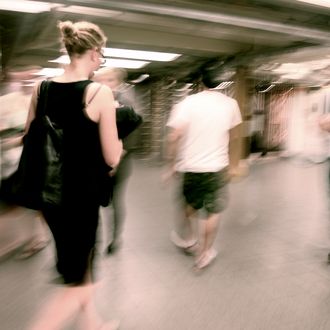
Monday morning, scientists working for the Department of Homeland Security will begin releasing (nontoxic) gases and particles on crowded subway platforms, beginning a week-long airflow study aimed at measuring the impact of a nightmarish chemical or biological terrorist attack.
It’s not the first such study — most recently the NYPD gassed the subway system in 2013 (also nontoxic) — but this is the first large-scale use of particles, in addition to gases. While gas tests help scientists, counter-terrorism specialists, and emergency responders understand the impact of chemical weapons like sarin gas or mustard gas, the particle test will measure the fallout from aerosol-dispensed biological agents like anthrax or ricin.
Every day this week, particles will be released from machines at busy stations like Grand Central, Times Square, 34th St.–Penn Station. Special machines and filters on platforms and subway cars will gather the particles. Researchers working throughout the system will also wear small patches designed to collect them.
The Department of Homeland Security, along with a MTA and a slew of other agencies, assured New Yorkers that neither the gases nor the particles are a health risk. The study won’t significantly increase the level of particle matter wafting through the air, in part, because New York City subway stations are already brimming with particulate. In fact, as the project’s assessment report noted, the levels of steel, manganese, and chromium in the subway system are 100 times higher than outdoors.
So how will researchers delineate between their particles and the dust cloud of iron, rubber, and God-knows-what floating around the platforms? A recent technology called DNATrax gives particles a kind of barcode, which enables researchers to identify their own particles. (DNATrax may soon be used to track food sourcing. The barcode can tell you exactly which tree your bad apple came from.) Because of this new technology, scientists can use their own particulate — sugar based (made from the same stuff as Splenda, in fact) with a diameter no bigger than one tenth of a human hair — instead of some other, more nefarious, substance.
In 1966, as part of a similar test, US Army scientists smashed light bulbs filled with charcoal and Bacillus subtilis, bacteria that can cause food poisoning. A mere five minutes after the bulbs were smashed at the 23rd Street Station, the bacteria could be detected at every station between 14th Street and 59th Street. After four days of testing, scientists concluded that more than a million people had been exposed. While the Army scientists noted no adverse affects on passengers, there was no data to prove it. It’s safe to assume they didn’t test a million people for food poisoning. By the researchers’ account, New Yorkers dealt with the cloud of charcoal and Bacillus subtilis, a literal biological attack, the same way they dealt with any other hazard on the commute. “When the cloud engulfed people, they brushed their clothing, looked up at the grating apron and walked on.”






























